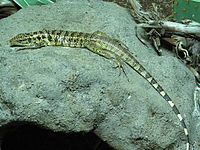Teiidae
| Teiidae | |
|---|---|
 |
|
| Tupinambis teguixin | |
| Scientific classification | |
| Kingdom: | Animalia |
| Phylum: | Chordata |
| Class: | Reptilia |
| Order: | Squamata |
| Infraorder: | Scincomorpha |
| Family: |
Teiidae Gray, 1827 |
| Genera | |
|
18, See text. |
|
18, See text.
Teiidae is a family of autarchoglossan lizards native to the Americas. Members of this family are generally known as whiptails or racerunners; however, tegus also belong to this family. Teiidae is sister to the Gymnopthalmidae, and both families comprise the Teiioidea. The Teiidae includes several parthenogenic species - a mode of clonal reproduction. Presently, the Teiidae consists of 151 species in eighteen genera.
Teiids can be distinguished from other lizards by the following characteristics: they have large rectangular scales that form distinct transverse rows ventrally and generally small granular scales dorsally, they have head scales that are separate from the skull bones, and the teiid teeth are solid at the base and "glued" to the jaw bones. Additionally, all teiids have a forked, snake-like tongue. They all possess well-developed limbs.
Teiids are all terrestrial (few are semi-aquatic) and diurnal, and are primarily carnivorous or insectivorous. Most teiids forage quite actively within their ideal temperature range, quickly skirting between cover objects. Some will include a small amount of plant matter in their diet. They are oviparous, and some species laying very large clutches.
Several species of whiptail lizards are entirely female and no males are known. These all-female species reproduce by obligate parthenogenesis (obligate, because the lizards do not involve males and cannot reproduce sexually). Like all squamate obligate parthenogenetic lineages, parthenogenetic Teiids are hybrids. Two or more species rarely hybridize and the offspring are thought to occasionally be capable of reproduction without sperm. The meiotic mechanism for bypassing fertilization is an ongoing area of research.
...
Wikipedia
